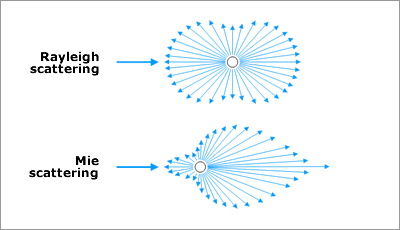Because Rayleigh scattering is much stronger at shorter wavelengths, blue light is scattered much more than light of longer wavelengths by the molecules of the atmosphere. In addition, although Rayleigh scattering is greater forwards and backwards in the incident plane, a significant amount of scattering takes place sideways: the amount of scattering at right angles to the incident plane is still half the forward intensity (in contrast to Mie scattering from larger particles, which is much stronger in the forward direction).

Fig 2.2.2.2.3.1: Rayleigh and Mie phase functions contrasted
Image: AT2-ELS
Because of this, when the observer looks away from the Sun, Rayleigh scattering predominates, making the sky appear blue. In a clear atmosphere without haze the blue colour of the sky appears more saturated as the observer looks further away from the Sun.
In contrast, when the observer looks at the sky in the general direction of the sun, Mie scattering — which is not very wavelength dependent and has a much stronger forward component than Rayleigh scattering — predominates. The sky around the sun is therefore perceived as paler blue.